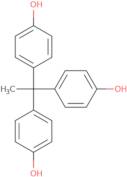1,1,1-Tris(4-hydroxyphenyl)ethane
CAS: 27955-94-8
Ref. 3D-FT62586
| 1kg | Descatalogado | ||
| 50g | Descatalogado | ||
| 100g | Descatalogado | ||
| 250g | Descatalogado | ||
| 500g | Descatalogado |
Información del producto
- 1,1,1-This(4-hydroxyphenyl)ethane
- 1,1,1-Tri(4-hydroxyphenyl)ethane
- 1,1,1-Tris(P-Hydroxyphenyl)Ethane
- 4,4',4''-(Ethylidene)Trisphenol
- 4,4',4''-Ethane-1,1,1-Triyltriphenol
- 4,4,4-(Ethylidene)trisphenol
- 4,4’,4’’-Ethylidynetri-Pheno
- 4,4’,4’’-Ethylidynetris-Pheno
- 4,4’,4’’-Ethylidynetrisphenol
- 4,4′,4′′-Ethane-1,1,1-triyltriphenol
- Ver más sinónimos
- 4,4′,4′′-Ethylidynetris[phenol]
- Bip-Phap
- Labotest-Bb Lt00159983
- Phenol, 4,4′,4′′-ethylidynetri-
- Phenol, 4,4′,4′′-ethylidynetris-
- Tris(4-Hydroxyphenyl)Ethane
- TrisP-HAP
1,1,1-Tris(4-hydroxyphenyl)ethane (TETP) is a chemical that is used in wastewater treatment. It reacts with hydrochloric acid to produce polycarbonates and hydrogen gas. TETP is also a good candidate for the production of polyurethanes. It reacts with polyols to form polyurethanes by the reaction mechanism of hydroxyl group and proton. The thermal expansion coefficient of TETP is about 1/10 that of PVC, so it can be used as a replacement for PVC in some applications such as dry weight materials. TETP has shown potential for use in the production of photoresistive coatings for semiconductors and storage media. In addition, its reactivity with certain organic compounds may be useful in the production of pharmaceuticals or other chemicals.
TETP has been shown to be safe and effective in mice experiments when administered orally at doses up to 2000 mg





